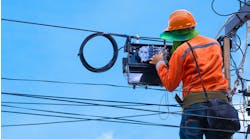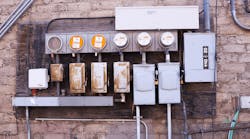The Continuing Saga
The issue of bonding and grounding is critical to effective outside plant, and particularly when broadband or Triple Play is implemented. My two-part column on this topic drew many, many responses, so thank you to all of you readers and to those who responded. I found the response from Mr. Percy Pool, a protection engineer, to be particularly insightful, and I want to share his entire, well-considered opinion on this topic.
The December 2011 column had, in my opinion, several errors. The National Electrical Code (NEC®) and the National Electrical Safety Code (NESC®) were used almost interchangeably. This led to errors in the citations and references made and their application.
The February 2012 column had some comments from Bob Olgeirson about which Code was used, or should have been used, that really did not clarify much so the confusion remained. To aggravate things more the recent March 2012 issue stated that,
The point where these two codes come together is the NID, including grounding of the NID. Usually the codes agree, but this year because they are published at different times they are not identical.
These sentences are not entirely correct either. Further, the March column included quotes from 5 or 6 NEC® articles without explanation as to their applicability to bonding and grounding and/or their similarities or differences, if any, to the NESC®.
So, we are back to square one so to speak!
Let’s start at the beginning. The original December column pointed out 5 problems that could affect the bandwidth associated with triple play service. Two of these problems dealt with bonding and grounding; PROBLEM #3: Bonding and grounding issues and PROBLEM #4: The Network Interface Ground. This last one is the one had had the most errors.
In many jurisdictions (but not all) the dividing line is half-way between the power transformer and the power service meter. So, half of the power service drop would be under the NEC® and the other under the NESC®. By the way, Figure 011-1 from the 2012 NESC® shows the applicability of both codes in a similar manner.
While figure 1 and NESC® figure 011-1, show the division between the Codes based on electrical facilities, one can apply similar logic to telecommunication facilities. Then, in the figure, the primary protector, NID [Network Interface Device] and ONT [Optical Network Terminal] would fall between the power service equipment (electric power meter) and the utilization equipment or load. Therefore the NID (for plain old telephone service) and ONT (for triple play service) fall under the jurisdiction of the NEC®.
So, if we accept the fact that the NID and ONT fall under the purview of the NEC® then we would conclude that only a 14 AWG bonding / grounding conductor is required [Article 800.100(A)(3)] at the protector or NID.
So, while it is true that the 2012 NESC® Rule 99B was changed to require a 6 AWG bonding / grounding conductor this change should not affect the typical station installation requirements for NIDs and ONTs. The local inspector will follow the NEC® and will accept 14 AWG (or coarser gauge).
Now, RUS, and any other service provider for that matter, can certainly establish any requirements they see fit. It seems that RUS has opted to require a 6 AWG grounding/bonding conductor at the NIDs and at the ONTs. That is well within their prerogative. However, when the electrical inspector checks the installation he, or she, will find it OK since the NEC® (not the NESC®!!) requires 14 AWG as a minimum.
I think the changes made to the NESC® Rule 99B are not enforceable; that is to say that the local inspectors follow the NEC® and will accept 14 AWG (or coarser gauge) until such a time as the NEC® is changed, if it ever does.
Let’s remember that the NESC® generally applies only to the outside plant cables.
The technicians installing the primary protector or NID should follow their company practices and procedures. These practices are typically prepared by the service provider’s technical staff support. This group needs to keep up to date not only with changes in the Codes but also changes in applicable National Standards (such as ATIS Standards) that oftentimes provides guidance to better understand the Code requirements.
In my professional opinion, a 6 AWG grounding/bonding conductor is not necessary especially in instances where the NID has only 1 or 2 protectors. There are no technical reasons that support the use of 6 AWG as a bonding/grounding conductor for NIDs. All the calculations made by Bell Labs, in the olden days, indicate that a 14 AWG is all that is necessary to provide the ground connection for a protector or two.
Both the NEC® and the NESC® Codes are changed from time to time based on changes recommended by the general public. The change approval process is quite thorough and sufficient justifications are required by the committee members before approval is granted. There is no mechanics in place to either reduce overlap between the NEC® and the NESC® or to provide synchronization of common or similar requirements. This can only be achieved if interested persons would submit change proposals for either case.
A Short Refresher
Purpose of Station Protection
The application of electrical protection, including bonding and grounding, at a customer location is intended to help ensure the safety of the technicians that install and maintain the telecommunications network. Electrical protection at the customer location also reduces the possibility of damages to the telephone plant and to the customer’s premises.
The possibility of damage resulting from contact with electric wires or from exposure to lightning can be significantly reduced where standard clearances are observed, primary protectors (and fusible links, where required) are properly installed and maintained, and cable and service wire shields and metallic strength members are properly bonded and grounded.
Abnormal voltages may develop on telecommunication systems as a result of power or lightning disturbances when telephone equipment and wiring are isolated from ground (earth) and from metallic or grounded structures such as water pipes, power conduit and wiring, and other communication facilities. The voltage differences that may exist between the various structures are equalized, or limited, by common bonding and grounding to reduce hazards and to prevent arcing and damages to equipment or property.
Article 800.90B of the 2011 National Electrical Code (NEC)® requires the primary protector (or NID) to be located in, on, or immediately adjacent to the structure or building served and as close as practicable to the point of entrance. The NEC® also requires the grounding conductor for the primary protector / NID to be as short as practicable. For one- and two-family dwellings, the grounding conductor for the primary protector is not to exceed 20 feet in length. For all practical purposes the primary protector / NID should be within 20 feet of the electrical service entry point.
When the protector (or NID) cannot be within 20 feet of the electrical service entry point the NEC® allows the placement of a separate ground rod to ground the protector / NID. However, the ground rod has to be bonded to the electrical service grounding electrode system. In this case, the NEC® requires that the power and telephone grounds be bonded together with a 6 AWG copper conductor.
The preferred location for placing, moving, or upgrading a protector (or NID) is on the outside, near the electrical service, and at an easily accessible location. This provides technicians with ease of access for maintenance and repair.
Communication service access wires, or drops, cannot be attached to service masts already supporting power conductors, or power service drops.
Primary Protectors
NEC® Article 800.90 requires that all exposed working pairs entering the customer location shall be protected by a primary protector. The primary protector is typically contained within a listed Network Interface Device (NID). The primary protector is commonly a set of gas tubes although newer hybrids (combination of gas tubes and solid state components) are available. Carbon protectors, although in place in many locations, are no longer the preferred protector.
The NID also contains the network interface, a plug-and-jack arrangement permitting the customer to disconnect the premises wiring from the telecommunications network, and a terminal strip or "bunching block" for the attachment of the customer premises wiring.
Selection of Grounds for NIDs
The primary protector shall always be connected to an approved ground via the shortest and straightest practical route.
The first choice for the primary protector ground shall be the nearest accessible location on the power grounding system, typically the power company ground rod. The power grounding system may be accessed at the power service entrance metallic conduit or the meter box. Other acceptable grounding points include the nearest accessible location on building steel and interior metallic water pipe (when bonded to the power ground and within 5 feet of the pipe’s entrance to the building).
Signing off
I am ever thankful to people like Mr. Pool and all the many others who help me educate you loyal readers. My goal is to provide up-to-date information that helps you do your job better. Please call or email if you have ideas on topics you’d like me to discuss. Email [email protected] or call 831.818.3930 (mobile) or 503.538.1229 (office).




